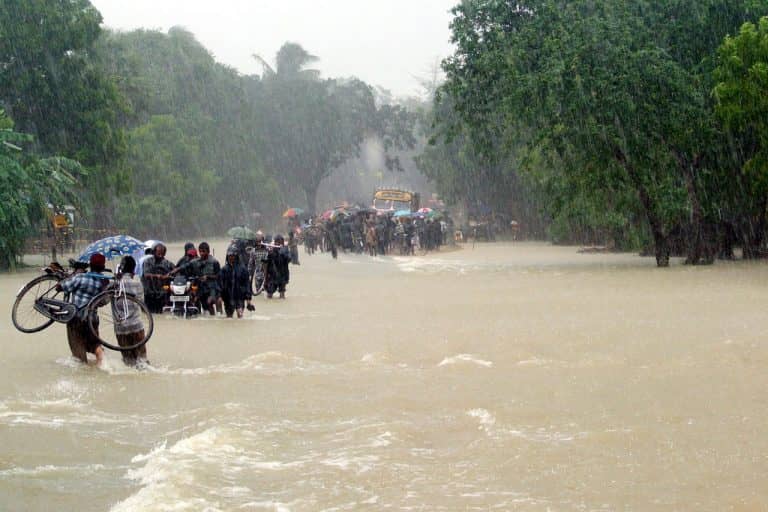
Sri Lanka is an island in the Indian Ocean just to the North of the Equator. There are two inter-monsoonal periods from March to April (first inter-monsoon – IM1) and from October to November (second inter-monsoon – IM2). Sri Lanka consists mainly of three climatic zones: The Wet Zone, Dry Zone and the Intermediate Zone. The El Nino-Southern Oscillation (ENSO) is a primary mode of climate variability in the South Asian region.1
Sri Lanka, particularly the dry zone, is primarily affected by rising day- and night-time temperatures, and shifting rainfall patterns. Observed average temperatures have increased by around 0.8°C over the course of the 20th century, with temperature rises accelerating toward the end of the century. 2
Temperature rise and rainfall variations in Anuradhapura and Trincomalee result in frequent drought, prolonged water scarcity, occasional foods, salinity development in lowland soils, soil degradation, high winds and loss of agricultural productivity, including for key staples such as paddy. Other impacts causing loss and damage (L&D) include pests and diseases, invasive alien species, and human-wildlife conflict. Climate stressors also result in decreasing fish populations and adversely affect the livestock.3 Both districts are located in the dry zone of the island and have a high agricultural output, providing almost one ffth of the country’s total paddy production, despite being home to only 6.3% of the population.4
Communities in the case study area experience economic and non-economic L&D due to droughts, erratic monsoon seasons, changes in rainfall patterns, foods, pests and diseases, and human-wildlife conflict.Virtually all surveyed households are engaged in smallholder agriculture as their main (or one of their main) sources of livelihood, and all households reported serious climate-related impacts over the past decade.5 In Sri Lanka, the observed forms of climate-related human mobility include seasonal/cyclical rural-urban migration, related to drought and declining agricultural livelihoods; environmental impacts leading to internal or international migration; disaster displacement from foods and landslides; and relocation of settlements away from landslide-prone areas.6
Climate change also increasingly causes a misalignment between traditional knowledge and changing weather patterns and climatic conditions, rendering traditional coping strategies less effective. Many ancient cascade tank systems have fallen into disrepair, are not being properly maintained, or suffer from siltation, salinity intrusion, and clogging from invasive alien species. This heightens the vulnerability of farming households to water scarcity, prolonged dry spells and drought. The situation gets worst due to lack of shock-responsive rural infrastructure, gaps in transport and storage infrastructure, limited financial resources, and low economic diversification, with few alternative employment and income options. Climate mobility in Sri Lanka also often exacerbates pre-existing gender-related issues.Overall, climate-related migration and displacement is connected to a loss of social cohesion at the community level, as families become increasingly fragmented and untethered from their heritage and traditional way of life. Both origin communities and host communities can be affected by this.
The shifting weather patterns and agroecological conditions have heightened the risks to agricultural livelihoods and point toward a strong need for integrated risk management and livelihood diversification. Around two thirds of the household members staying behind reported fnancial problems and a lack of proper income related to yield reduction or failed harvests. This suggests a strong connection between climate change, poverty and migration.6
Migrants and their communities also need support. But there is no comprehensive policy framework that jointly addresses climate change and migration, and there are gaps in institutional coordination and information exchange. Migrants are often part of the informal sector and not included in many data collection processes, making it diffcult for them to access services, have continuity of healthcare, and manage climate-related risks. It is important to consider the evidence-based integration of human mobility concerns into policies, plans, processes and actions, as well as share good practices with networks and organisations from regional to national levels.
-
Addressing The Human Rights Implications Of Climate Change Displacement
Submission to the UN Special Rapporteur on the Promotion and Protection of Human Rights in the Context of Climate Change “Addressing the human rights implications of climate change displacement including …
-
Everything you need to know about the Loss and Damage Fund
The series of extreme weather events in 2022 fuelled by climate change that devastated lives and livelihoods of millions – from the floods in Pakistan and China to droughts in …
-
Ethiopia: Drought is hitting Ethiopia harder than ever
The UN estimates that 4.5 million livestock have so far died due to lack of water and pasture. Millions more are weak and starving. This means traders are unwilling to …



